Joint Estimation Method with Multi-Innovation Unscented Kalman Filter Based on Fractional-Order Model for State of Charge and State of Health Estimation
Abstract
1. Introduction
2. Experimental Platform and Parameter Identification
2.1. Experimental Platform
2.2. Battery Model and Parameter Identification
2.2.1. Battery Model
2.2.2. Parameter Identification
Parameter Identification of Integer-Order Model
Parameter Identification of Fractional-Order Model
2.3. UKF and Multi-Information
3. Experimental Validation and Discussion
3.1. SOC Estimation
3.1.1. FTP75
3.1.2. Japan
3.1.3. NEDC
3.1.4. WLTC
3.2. Terminal Voltage Estimation
3.2.1. FTP75
3.2.2. Japan
3.2.3. NEDC
3.2.4. WLTC
3.3. SOH Estimation
4. Summary and Conclusions
Author Contributions
Funding
Institutional Review Board Statement
Informed Consent Statement
Data Availability Statement
Conflicts of Interest
Nomenclature
| V | Voltage (V) |
| R | resistance (Ω) |
| C | capacitance (F) |
| Vm | measured voltage (V) |
| VLS | Estimation voltage with least square integer-order model (V) |
| VFO | Estimation voltage with fractional-order model (V) |
| FOM | fractional-order model |
| IOM | integer-order model |
| SOC | state of charge |
| SOH | state of health |
| EKF | extended Kalman filter |
| UKF | unscented Kalman filter |
| MI | multi-innovation |
| RUL | remaining useful life |
| EVM | equivalent circuit model |
| OCV | open circuit voltage |
| RMSE | root mean squared error |
| MAE | mean absolute error |
| AGA | adaptive genetic algorithm |
| LS | least square |
| FOUKF | fractional-order model unscented Kalman filter |
| FOMIUKF | fractional-order model multi-innovation unscented Kalman filter |
References
- Huo, W.; Li, W.; Zhang, Z.; Sun, C.; Zhou, F.; Gong, G. Performance prediction of proton-exchange membrane fuel cell based on convolutional neural network and random forest feature selection. Energy Convers. Manag. 2021, 243, 114367. [Google Scholar] [CrossRef]
- Xu, Y.; Zhang, H.; Yang, F.; Tong, L.; Yang, Y.; Yan, D.; Wang, C.; Ren, J.; Wu, Y. Experimental study on small power generation energy storage device based on pneumatic motor and compressed air. Energy Convers. Manag. 2021, 234, 113949. [Google Scholar] [CrossRef]
- Wang, B.; Yu, X.; Xu, H.; Wu, Q.; Wang, L.; Huang, R.; Li, Z.; Zhou, Q. Scenario analysis, management, and optimization of a new Vehicle-to-Micro-Grid (V2μG) network based on off-grid renewable building energy systems. Appl. Energy 2022, 325, 119873. [Google Scholar] [CrossRef]
- Zhang, S.; Hao, X.; Chen, Y.; Wu, J. Thermodynamic study on power and refrigeration cogeneration Kalina cycle with adjustable refrigeration temperature. Int. J. Refrig. 2021, 131, 706–713. [Google Scholar] [CrossRef]
- Gao, Y.; Wang, X.; Shu, G.; Tian, H.; Shi, X. Applicability analysis of waste heat recovery technology and strategy exploration for hybrid electric vehicles under diverse road conditions. Energy Convers. Manag. 2021, 230, 113780. [Google Scholar] [CrossRef]
- Xu, Y.; Zhang, H.; Yang, F.; Tong, L.; Yan, D.; Yang, Y.; Ren, J.; Ma, L.; Wang, Y. State of charge estimation of supercapacitors based on multi-innovation unscented Kalman filter under a wide temperature range. Int. J. Energy Res. 2022, 46, 16716–16735. [Google Scholar] [CrossRef]
- Shrivastava, P.; Soon, T.; Idris, M.; Mekhilef, S. Overview of model-based online state-of-charge estimation using Kalman filter family for lithium-ion batteries. Renew. Sustain. Energy Rev. 2019, 113, 109233. [Google Scholar] [CrossRef]
- Yang, B.; Wang, J.; Cao, P.; Zhu, T.; Shu, H.; Chen, J.; Zhang, J.; Zhu, J. Overview of model-based online state-of-charge estimation using Kalman of lithium-ion batteries used in electric vehicles: A critical comprehensive survey. J. Energy Storage 2021, 39, 102572. [Google Scholar] [CrossRef]
- Wang, Y.; Gao, G.; Li, X.; Chen, Z. A fractional-order model-based state estimation approach for lithium-ion battery and ultra-capacitor hybrid power source system considering load trajectory. J. Power Sources 2020, 449, 227543. [Google Scholar] [CrossRef]
- Ruan, H.; Sun, B.; Jiang, J.; Zhang, W.; He, X.; Su, X.; Bian, J.; Gao, W. A modified-electrochemical impedance spectroscopy-based multi-time-scale fractional-order model for lithium-ion batteries. Electrochim. Acta 2021, 394, 139066. [Google Scholar] [CrossRef]
- Zhang, Q.; Shang, Y.; Li, Y.; Cui, N.; Duan, B.; Zhang, C. A novel fractional variable-order equivalent circuit model and parameter identification of electric vehicle Li-ion batteries. ISA Trans. 2020, 97, 448–457. [Google Scholar] [CrossRef] [PubMed]
- Eddine, A.; Huard, B.; Gabano, J.; Poinot, T. Initialization of a fractional order identification algorithm applied for lithium-ion battery modeling in time domain. Commun. Nonlinear Sci. Numer. Simul. 2018, 59, 375–386. [Google Scholar] [CrossRef]
- Sanchez, L.; Otero, J.; Ansean, D.; Couso, I. Health assessment of LFP automotive batteries using a fractional-order neural network. Neurocomputing 2020, 391, 345–354. [Google Scholar] [CrossRef]
- Zou, C.; Zhang, L.; Hu, X.; Wang, Z.; Wik, T.; Pecht, M. A review of fractional-order techniques applied to lithium-ion batteries, lead-acid batteries, and supercapacitors. J. Power Sources 2018, 390, 286–296. [Google Scholar] [CrossRef]
- Hidalgo-Reyes, J.; Gomez-Aguilar, J.; Alvarado-Martinez, V.; Lopez-Lopez, M.; Escobar-Jimenez, R. Battery state-of-charge estimation using fractional extended Kalman filter with Mittag-Leffler memory. Alex. Eng. J. 2020, 59, 1919–1929. [Google Scholar] [CrossRef]
- Meng, J.; Boukhnifer, M.; Diallo, D. Lithium-Ion Battery Monitoring and Observability Analysis with Extended Equivalent Circuit Model. In Proceedings of the 2020 28th Mediterranean Conference on Control and Automation (MED), Saint-Raphaël, France, 15–18 September 2020; IEEE: Piscataway, NJ, USA, 2020; pp. 764–769. [Google Scholar]
- Fotouhi, A.; Auger, D.; Propp, K.; Longo, S. Lithium–sulfur battery state-of-charge observability analysis and estimation. IEEE Trans. Power Electron. 2017, 33, 5847–5859. [Google Scholar] [CrossRef]
- Rausch, M.; Streif, S.; Pankiewitz, C.; Findeisen, R. Nonlinear observability and identifiability of single cells in battery packs. In Proceedings of the 2013 IEEE International Conference on Control Applications (CCA), Hyderabad, India, 28–30 August 2013; IEEE: Piscataway, NJ, USA, 2013; pp. 401–406. [Google Scholar]
- Zhao, S.; Duncan, S.; Howey, D. Observability analysis and state estimation of lithium-ion batteries in the presence of sensor biases. IEEE Trans. Control Syst. Technol. 2016, 25, 326–333. [Google Scholar] [CrossRef]
- Fotouhi, A.; Auger, D.; Propp, K.; Longo, S. Electric vehicle battery parameter identification and SOC observability analysis: NiMH and Li-S case studies. IET Power Electron. 2017, 10, 1289–1297. [Google Scholar] [CrossRef]
- Ahmed, M.; Raihan, S.; Balasingam, B. A scaling approach for improved state of charge representation in rechargeable batteries. Appl. Energy 2020, 267, 114880. [Google Scholar] [CrossRef]
- Sun, D.; Yu, X.; Wang, C.; Zhang, C.; Huang, R.; Zhou, Q.; Amietszajew, T.; Bhagat, R. State of charge estimation for lithium-ion battery based on an Intelligent Adaptive Extended Kalman Filter with improved noise estimator. Energy 2021, 214, 119025. [Google Scholar] [CrossRef]
- Wang, Y.; Chen, Z. A framework for state-of-charge and remaining discharge time prediction using unscented particle filter. Appl. Energy 2020, 260, 114324. [Google Scholar] [CrossRef]
- Knap, V.; Stroe, D. Effects of open-circuit voltage tests and models on state-of-charge estimation for batteries in highly variable temperature environments: Study case nano-satellites. J. Power Sources 2021, 498, 229913. [Google Scholar] [CrossRef]
- Zhu, R.; Duan, B.; Zhang, J.; Zhang, Q.; Zhang, C. Co-estimation of model parameters and state-of-charge for lithium-ion batteries with recursive restricted total least squares and unscented Kalman filter. Appl. Energy 2020, 277, 115494. [Google Scholar] [CrossRef]
- Sun, C.; Lin, H.; Cai, H.; Gao, M.; Zhu, C.; He, Z. Improved parameter identification and state-of-charge estimation for lithium-ion battery with fixed memory recursive least squares and sigma-point Kalman filter. Electrochim. Acta 2021, 387, 138501. [Google Scholar] [CrossRef]
- Xue, Z.; Zhang, Y.; Cheng, C.; Ma, G. Remaining useful life prediction of lithium-ion batteries with adaptive unscented kalman filter and optimized support vector regression. Neurocomputing 2020, 376, 95–102. [Google Scholar] [CrossRef]
- Křivík, P.; Vaculík, S.; Bača, P.; Kazelle, J. Determination of state of charge of lead-acid battery by EIS. J. Energy Storage 2019, 21, 581–585. [Google Scholar] [CrossRef]
- Ling, L.; Sun, D.; Yu, X.; Huang, R. State of charge estimation of Lithium-ion batteries based on the probabilistic fusion of two kinds of cubature Kalman filters. J. Energy Storage 2021, 43, 103070. [Google Scholar] [CrossRef]
- Girade, P.; Shah, H.; Kaushik, K.; Patheria, A.; Xu, B. Comparative analysis of state of charge based adaptive supervisory control strategies of plug-in Hybrid Electric Vehicles. Energy 2021, 230, 120856. [Google Scholar] [CrossRef]
- Loukil, J.; Masmoudi, F.; Derbel, N. A real-time estimator for model parameters and state of charge of lead acid batteries in photovoltaic applications. J. Energy Storage 2021, 34, 102184. [Google Scholar] [CrossRef]
- Ragone, M.; Yurkiv, V.; Ramasubramanian, A.; Kashir, B.; Mashayek, F. Data driven estimation of electric vehicle battery state-of-charge informed by automotive simulations and multi-physics modeling. J. Power Sources 2021, 483, 229108. [Google Scholar] [CrossRef]
- Ee, Y.; Tey, K.; Lim, K.; Shrivastava, P.; Adnan, S.B.R.S.; Ahmad, H. Lithium-Ion Battery State of Charge (SOC) Estimation with Non-Electrical parameter using Uniform Fiber Bragg Grating (FBG). J. Energy Storage 2021, 40, 102704. [Google Scholar] [CrossRef]
- Sandoval-Chileño, M.; Castañeda, L.; Luviano-Juárez, A.; Gutierrez-Frias, O.; Vazque-Arenas, J. Robust State of Charge estimation for Li-ion batteries based on Extended State Observers. J. Energy Storage 2020, 31, 101718. [Google Scholar] [CrossRef]
- Ceraolo, M.; Lutzemberger, G.; Poli, D.; Scarpelli, C. Luenberger-based State-Of-Charge evaluation and experimental validation with lithium cells. J. Energy Storage 2020, 30, 101534. [Google Scholar] [CrossRef]
- Li, W.; Rentemeister, M.; Badeda, J.; Jost, D.; Schulte, D.; Sauer, D. Digital twin for battery systems: Cloud battery management system with online state-of-charge and state-of-health estimation. J. Energy Storage 2020, 30, 101557. [Google Scholar] [CrossRef]
- Li, Y.; Wang, C.; Gong, J. A combination Kalman filter approach for State of Charge estimation of lithium-ion battery considering model uncertainty. Energy 2016, 109, 933–946. [Google Scholar] [CrossRef]
- Liu, Z.; Dang, X.; Jing, B. A novel open circuit voltage based state of charge estimation for lithium-ion battery by multi-innovation Kalman filter. IEEE Access 2019, 7, 49432–49447. [Google Scholar] [CrossRef]
- Ding, F.; Wang, X.; Mao, L.; Xu, L. Joint state and multi-innovation parameter estimation for time-delay linear systems and its convergence based on the Kalman filtering. Digit. Signal Process. 2017, 62, 211–223. [Google Scholar] [CrossRef]
- Sassi, H.; Errahimi, F.; ES-Sbai, N. State of charge estimation by multi-innovation unscented Kalman filter for vehicular applications. J. Energy Storage 2020, 32, 101978. [Google Scholar] [CrossRef]
- Cui, X.; Xu, B. State of Charge Estimation of Lithium-ion Battery Using Robust Kernel Fuzzy Model and Multi-innovation UKF Algorithm under Noise. IEEE Trans. Ind. Electron. 2022, 69, 11121–11131. [Google Scholar] [CrossRef]
- Liu, B.; Tang, X.; Gao, F. Joint estimation of battery state-of-charge and state-of-health based on a simplified pseudo-two-dimensional model. Electrochim. Acta 2020, 344, 136098. [Google Scholar] [CrossRef]
- Song, Y.; Liu, D.; Liao, H.; Peng, Y. A hybrid statistical data-driven method for on-line joint state estimation of lithium-ion batteries. Appl. Energy 2020, 261, 114408. [Google Scholar] [CrossRef]
- Xiong, R.; Wang, J.; Shen, W.; Tian, J.; Mu, H. Co-estimation of State of charge and capacity for Lithium-ion batteries with multi-stage model fusion method. Engineering 2021, 7, 1469–1482. [Google Scholar] [CrossRef]
- Zhang, S.; Zhang, X. Joint estimation method for maximum available energy and state-of-energy of lithium-ion battery under various temperatures. J. Power Sources 2021, 506, 230132. [Google Scholar] [CrossRef]
- Li, X.; Long, T.; Tian, J.; Tian, Y. Multi-state joint estimation for a lithium-ion hybrid capacitor over a wide temperature range. J. Power Sources 2020, 479, 228677. [Google Scholar] [CrossRef]
- Li, P.; Zhang, Z.; Xiong, Q.; Ding, B.; Hou, J.; Luo, D.; Rong, Y.; Li, S. State-of-health estimation and remaining useful life prediction for the lithium-ion battery based on a variant long short term memory neural network. J. Power Sources 2020, 459, 228069. [Google Scholar] [CrossRef]
- Cui, Z.; Wang, C.; Gao, X.; Tian, S. State of health estimation for lithium-ion battery based on the coupling-loop nonlinear autoregressive with exogenous inputs neural network. Electrochim. Acta 2021, 393, 139047. [Google Scholar] [CrossRef]
- Yang, Q.; Xu, J.; Li, X.; Xu, D.; Cao, B. State-of-health estimation of lithium-ion battery based on fractional impedance model and interval capacity. Int. J. Electr. Power Energy Syst. 2020, 119, 105883. [Google Scholar] [CrossRef]
- Propp, K.; Auger, D.; Fotouhi, A.; Marinescu, M.; Vaclav, K.; Longo, S. Improved state of charge estimation for lithium-sulfur batteries. J. Energy Storage 2019, 26, 100943. [Google Scholar] [CrossRef]
- Meng, J.; Boukhnifer, M.; Diallo, D.; Wang, T. A new cascaded framework for lithium-ion battery state and parameter estimation. Appl. Sci. 2020, 10, 1009. [Google Scholar] [CrossRef]
- Park, J.; Lee, M.; Kim, G.; Park, S.; Kim, J. Integrated approach based on dual extended Kalman filter and multivariate autoregressive model for predicting battery capacity using health indicator and SOC/SOH. Energies 2020, 13, 2138. [Google Scholar] [CrossRef]
- Lai, X.; Yuan, M.; Tang, X.; Yao, Y.; Weng, J.; Cao, F.; Ma, W.; Zheng, Y. Co-Estimation of State-of-Charge and State-of-Health for Lithium-Ion Batteries Considering Temperature and Ageing. Energies 2022, 15, 7416. [Google Scholar] [CrossRef]
- Xu, Y.; Chen, X.; Zhang, H.; Yang, F.; Tong, L.; Yang, Y.; Yan, D.; Yang, A.; Yu, M.; Liu, Z.; et al. Online identification of battery model parameters and joint state of charge and state of health estimation using dual particle filter algorithms. Int. J. Energy Res. 2022, 46, 19615–19652. [Google Scholar] [CrossRef]
- Wang, B.; Li, S.; Peng, H.; Liu, Z. Fractional-order modeling and parameter identification for lithium-ion batteries. J. Power Sources 2015, 293, 151–161. [Google Scholar] [CrossRef]
- Peng, N.; Zhang, S.; Guo, X.; Zhang, X. Online parameters identification and state of charge estimation for lithium-ion batteries using improved adaptive dual unscented Kalman filter. Int. J. Energy Res. 2021, 45, 975–990. [Google Scholar] [CrossRef]

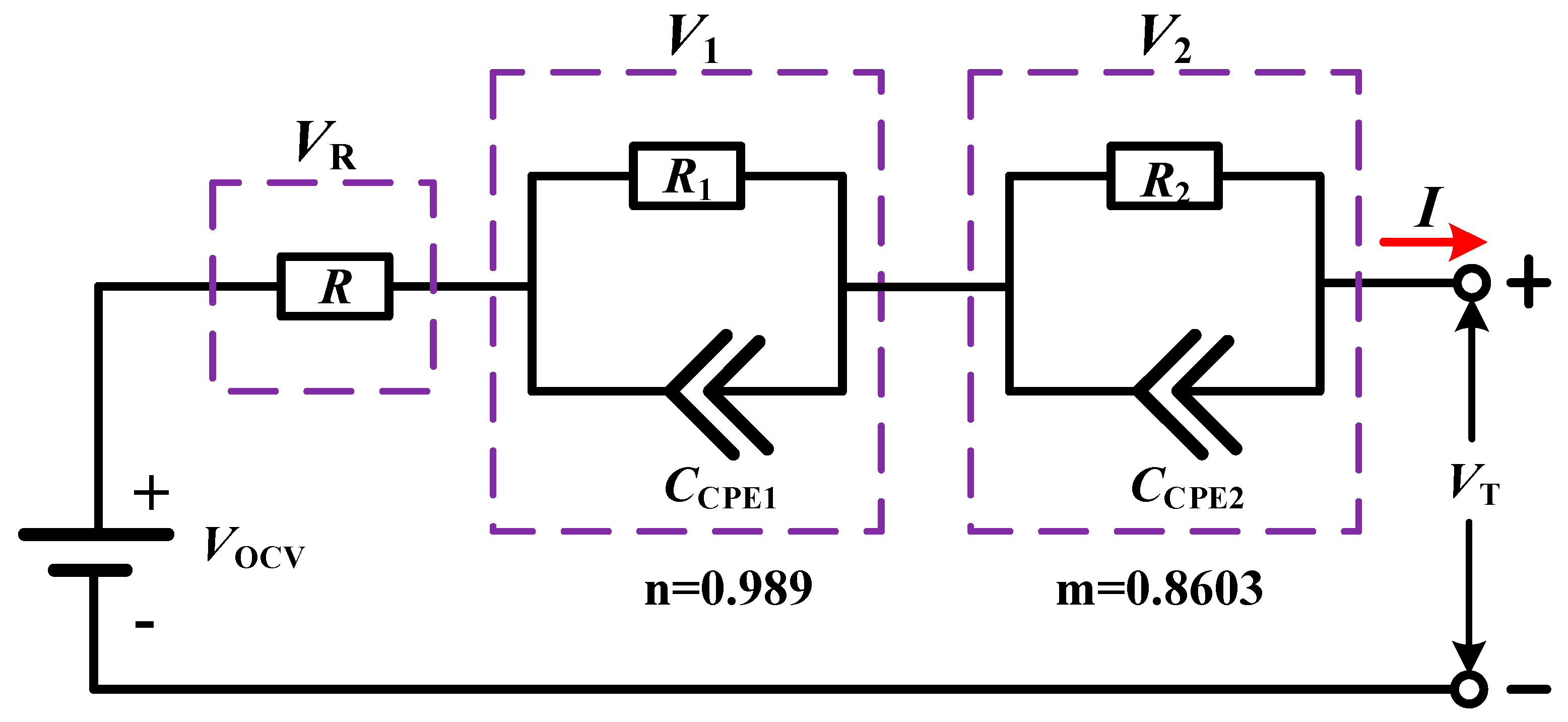
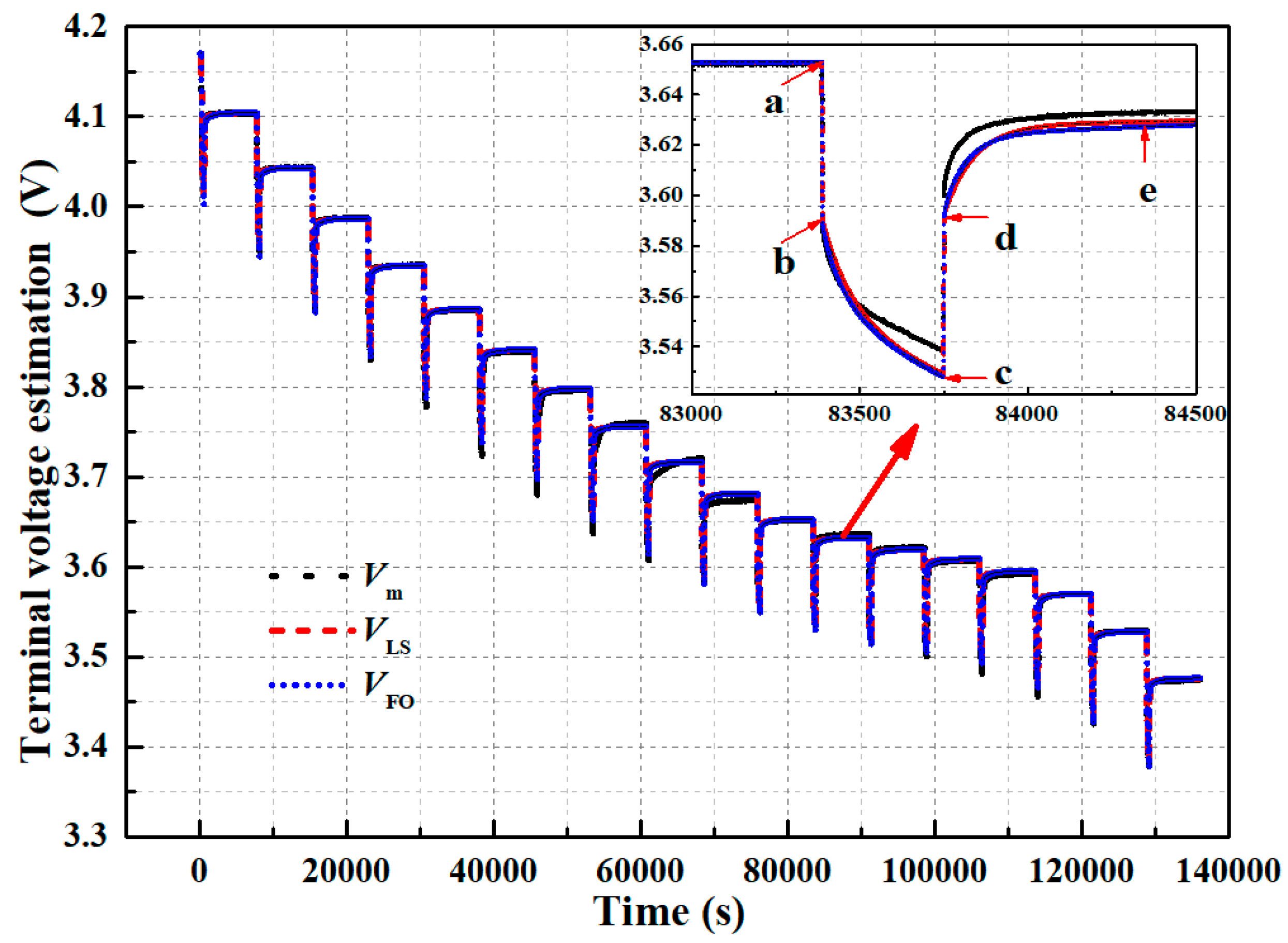

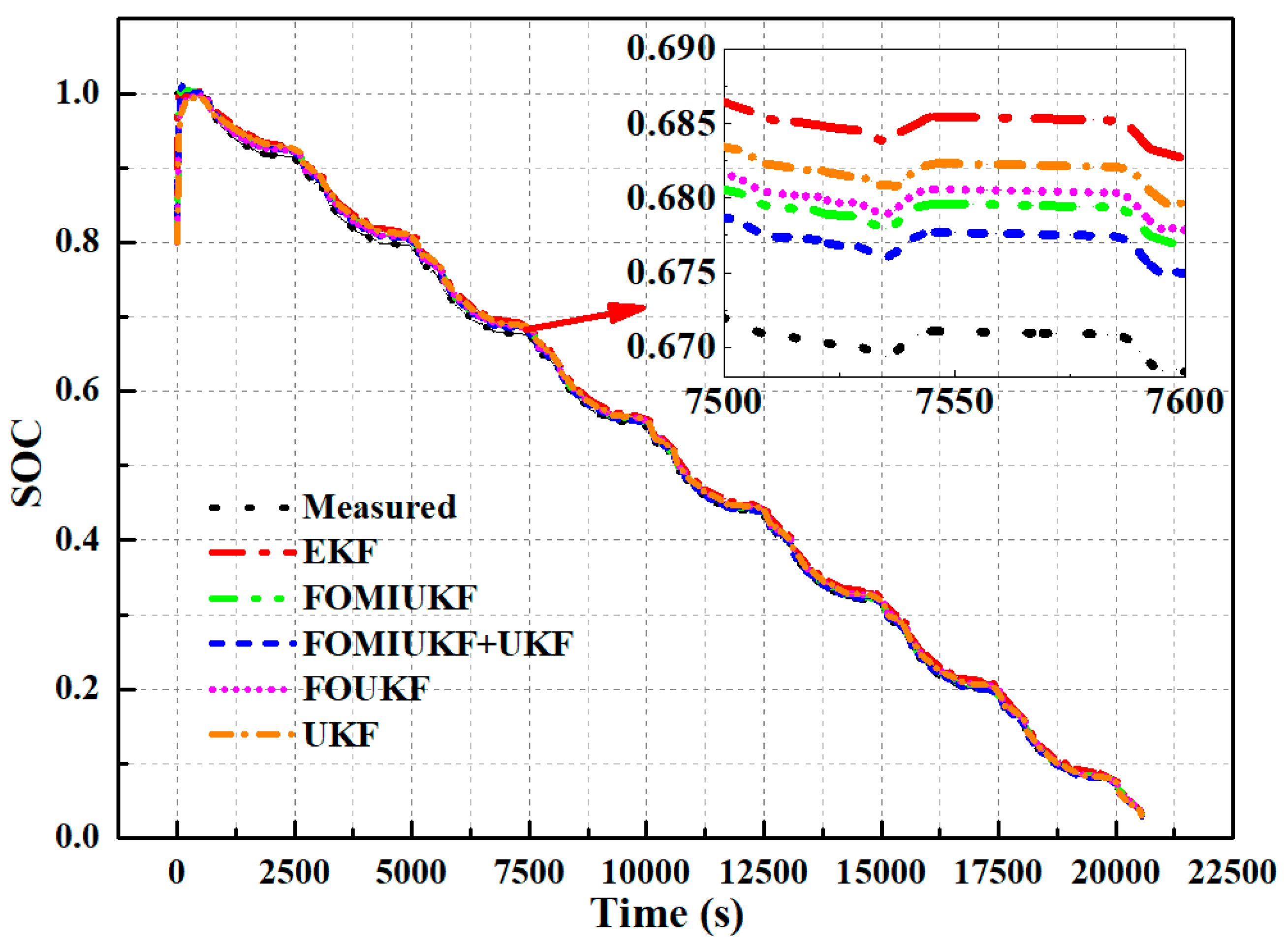
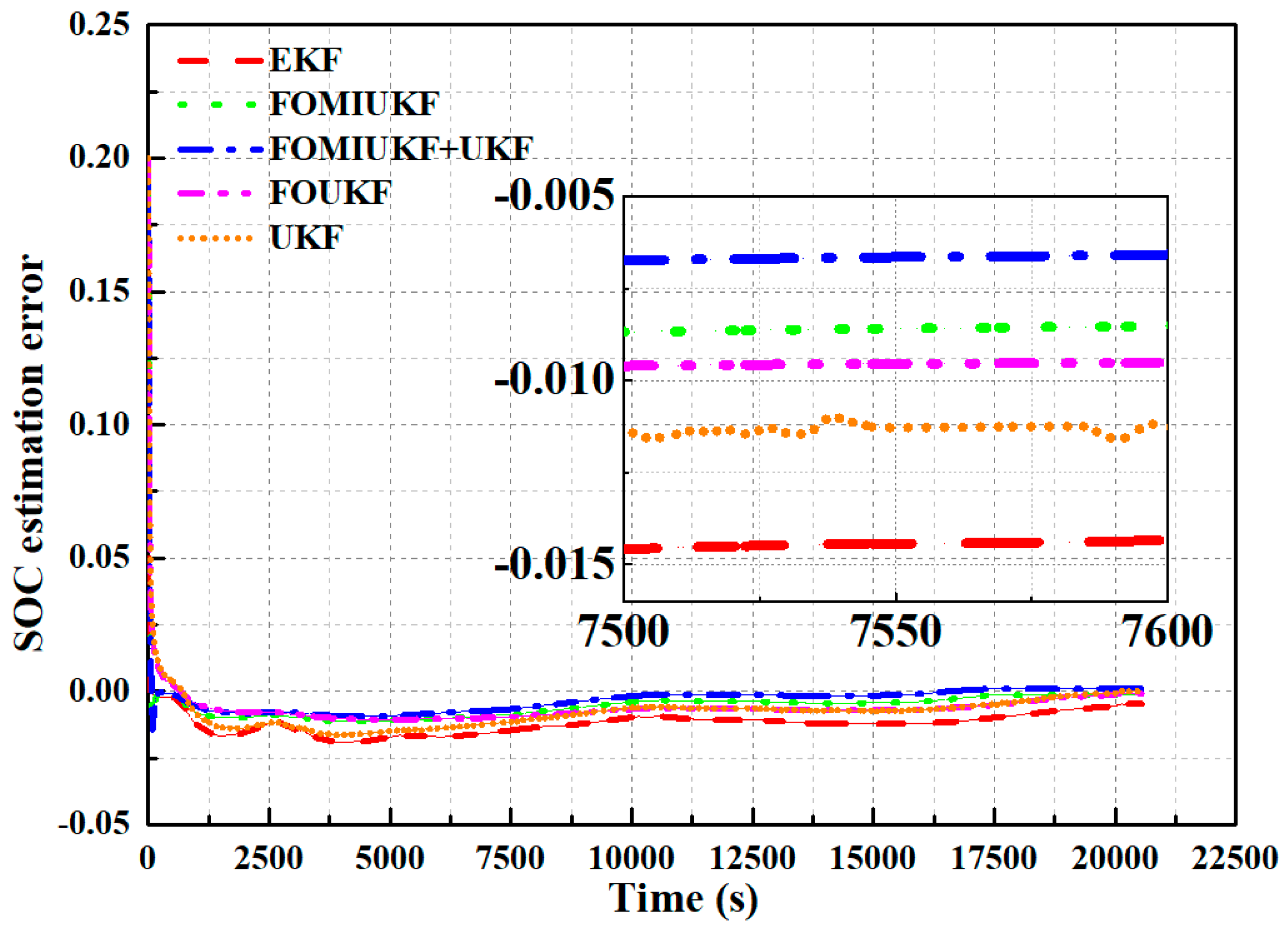

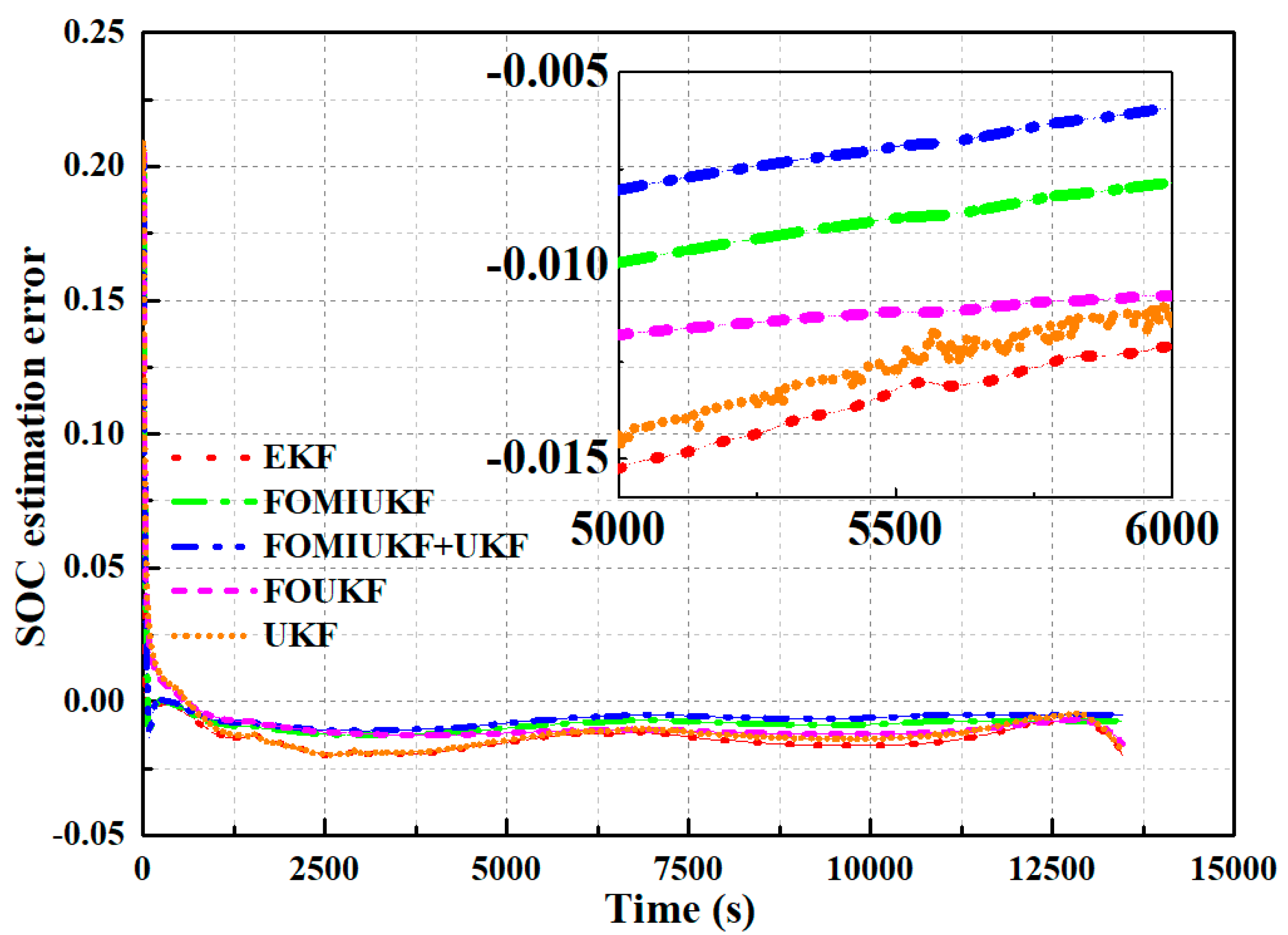
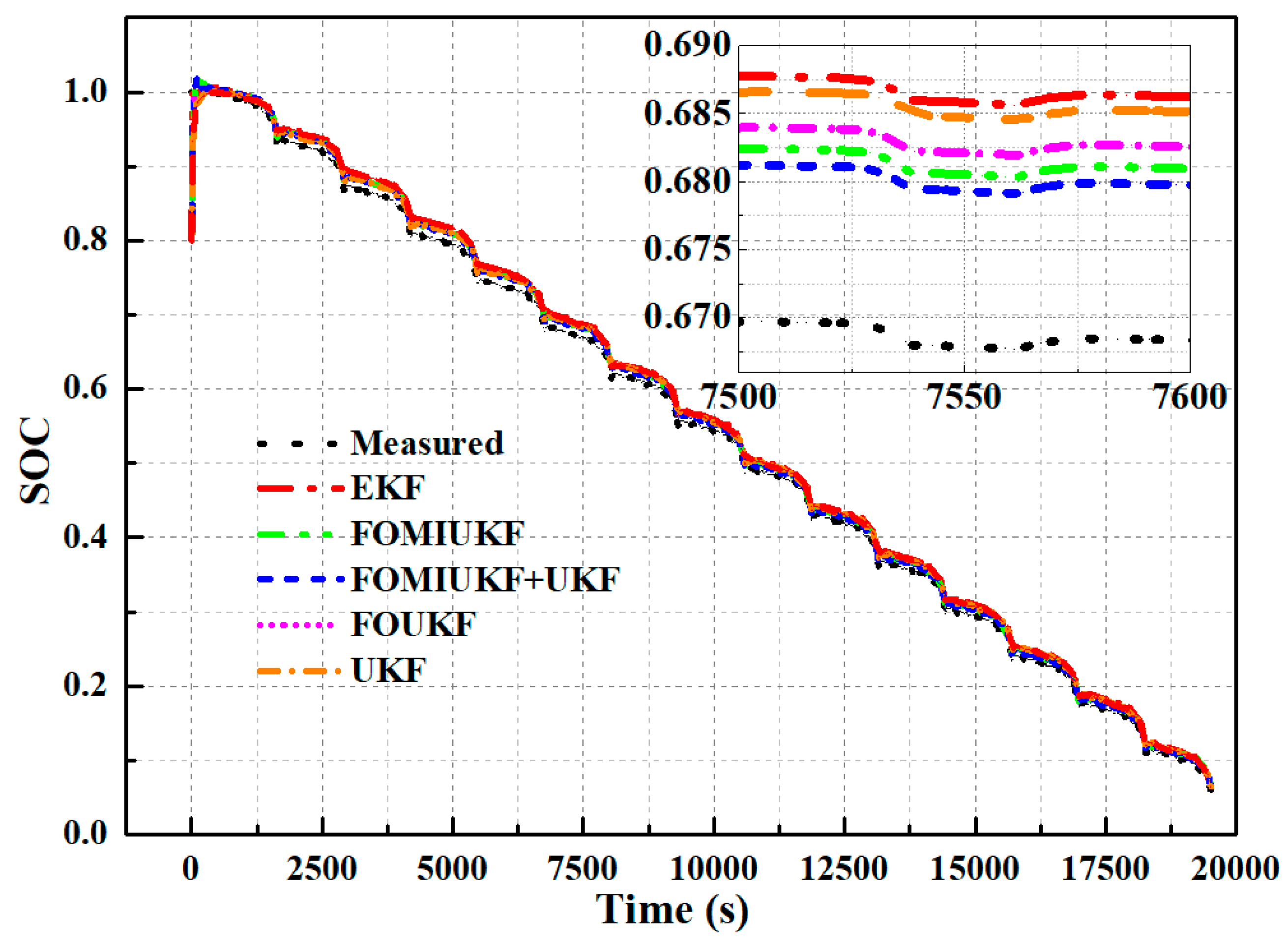
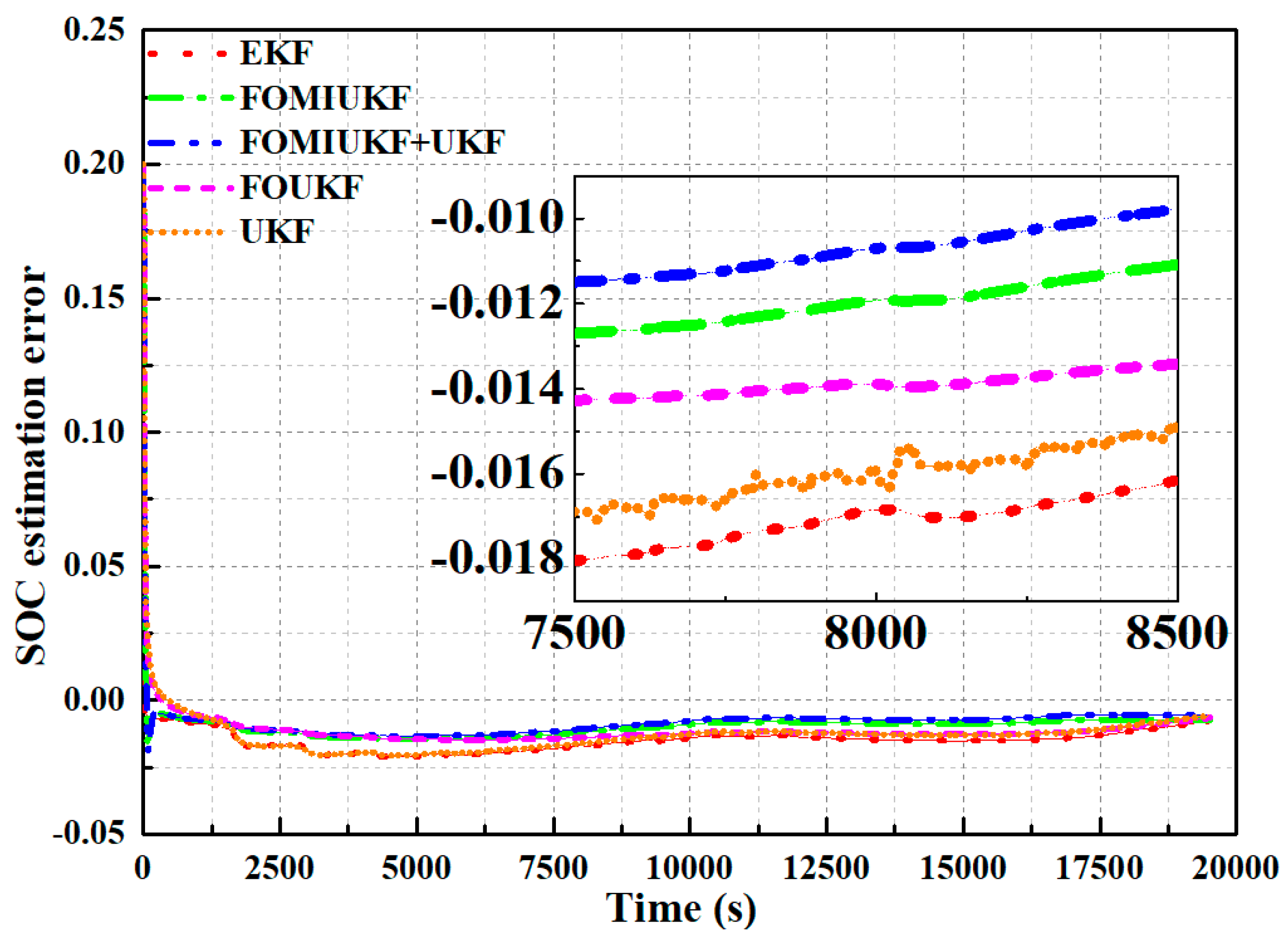
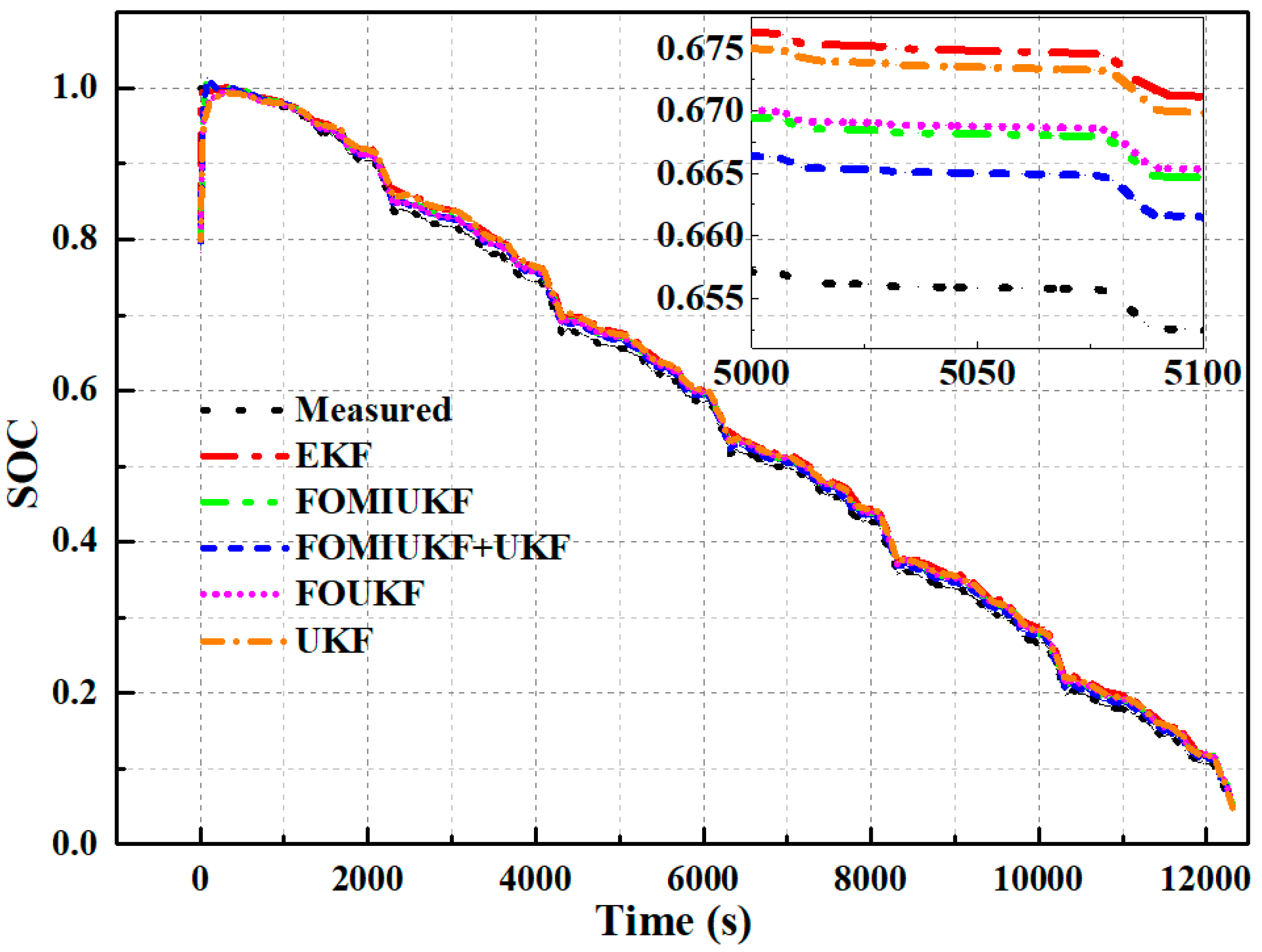

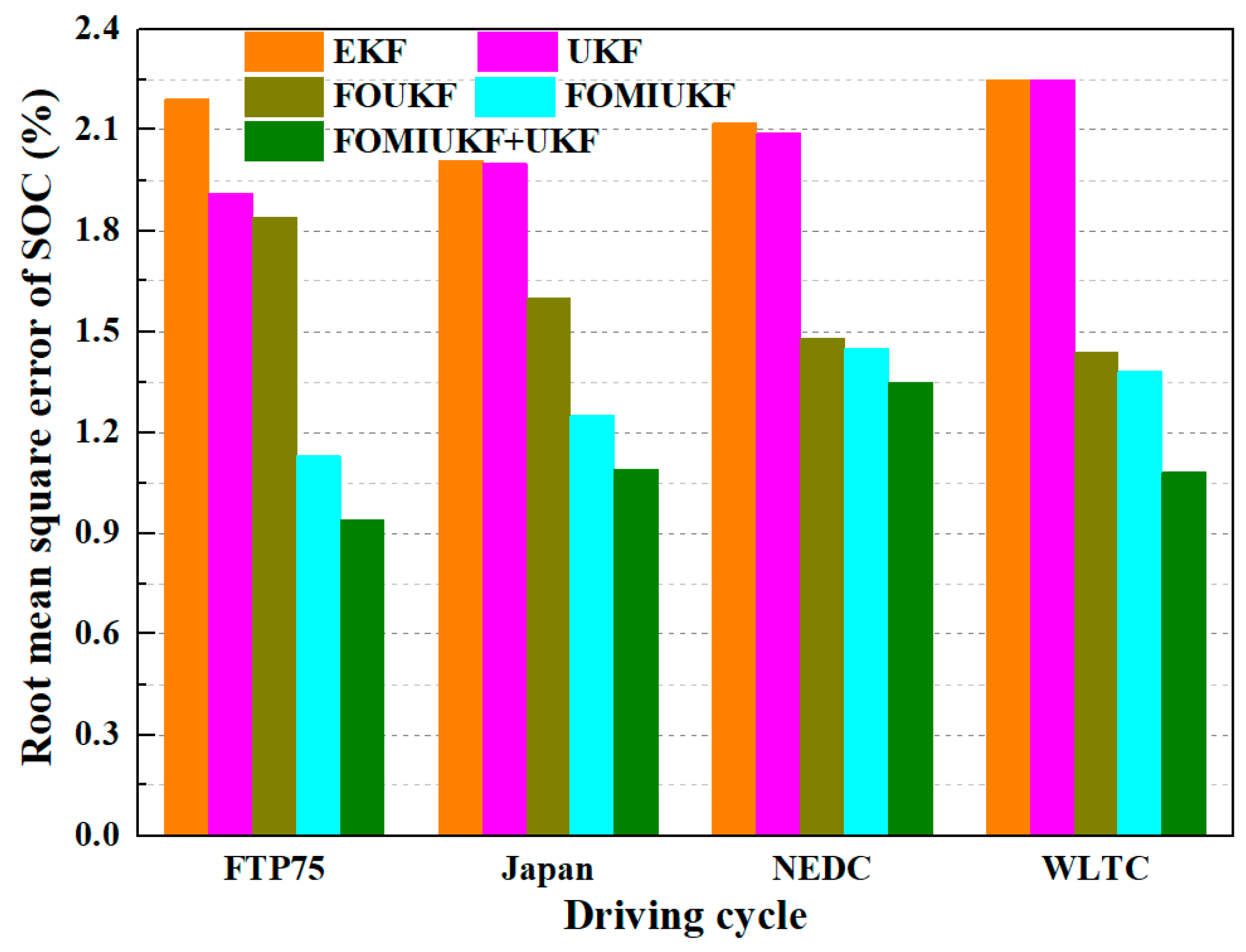
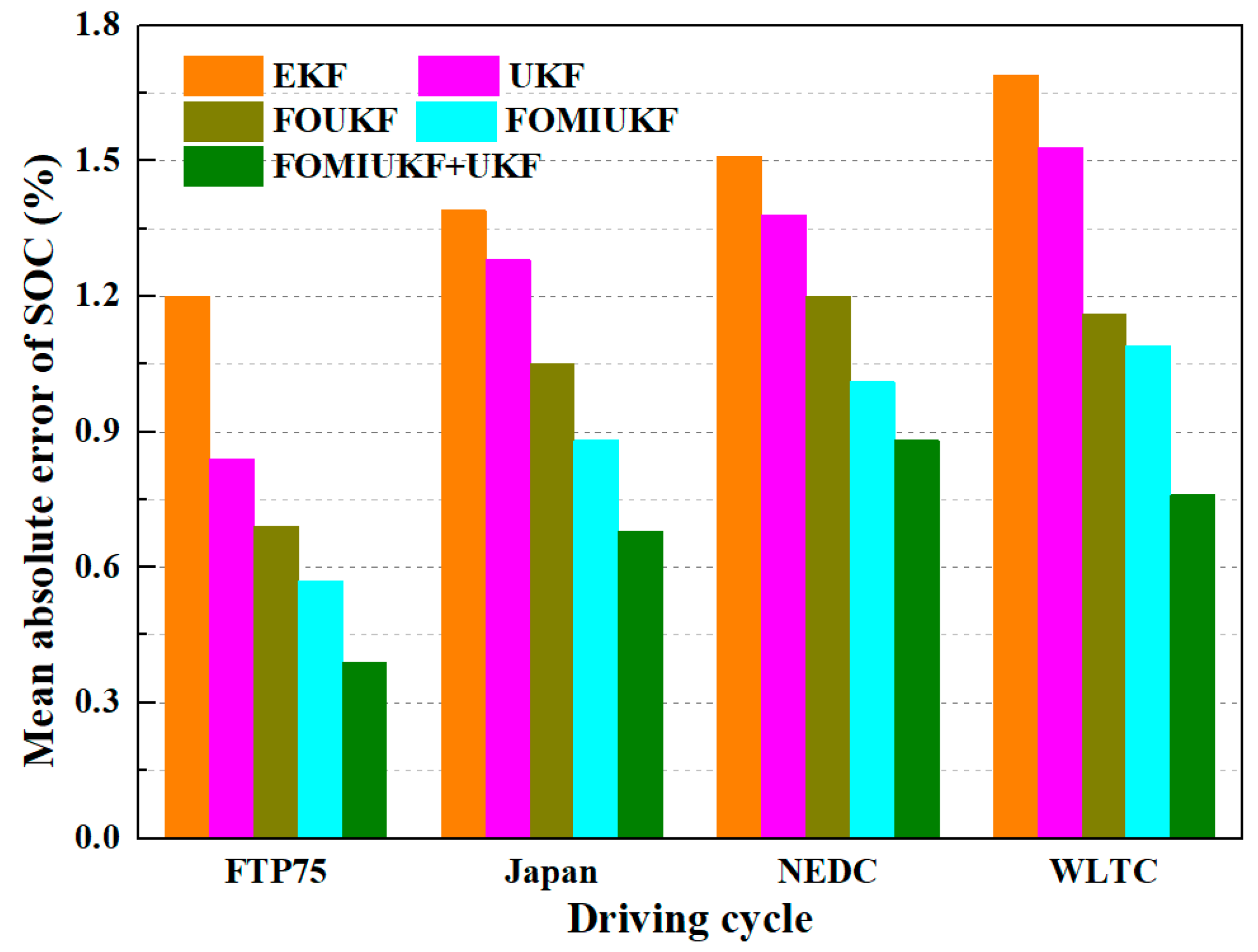

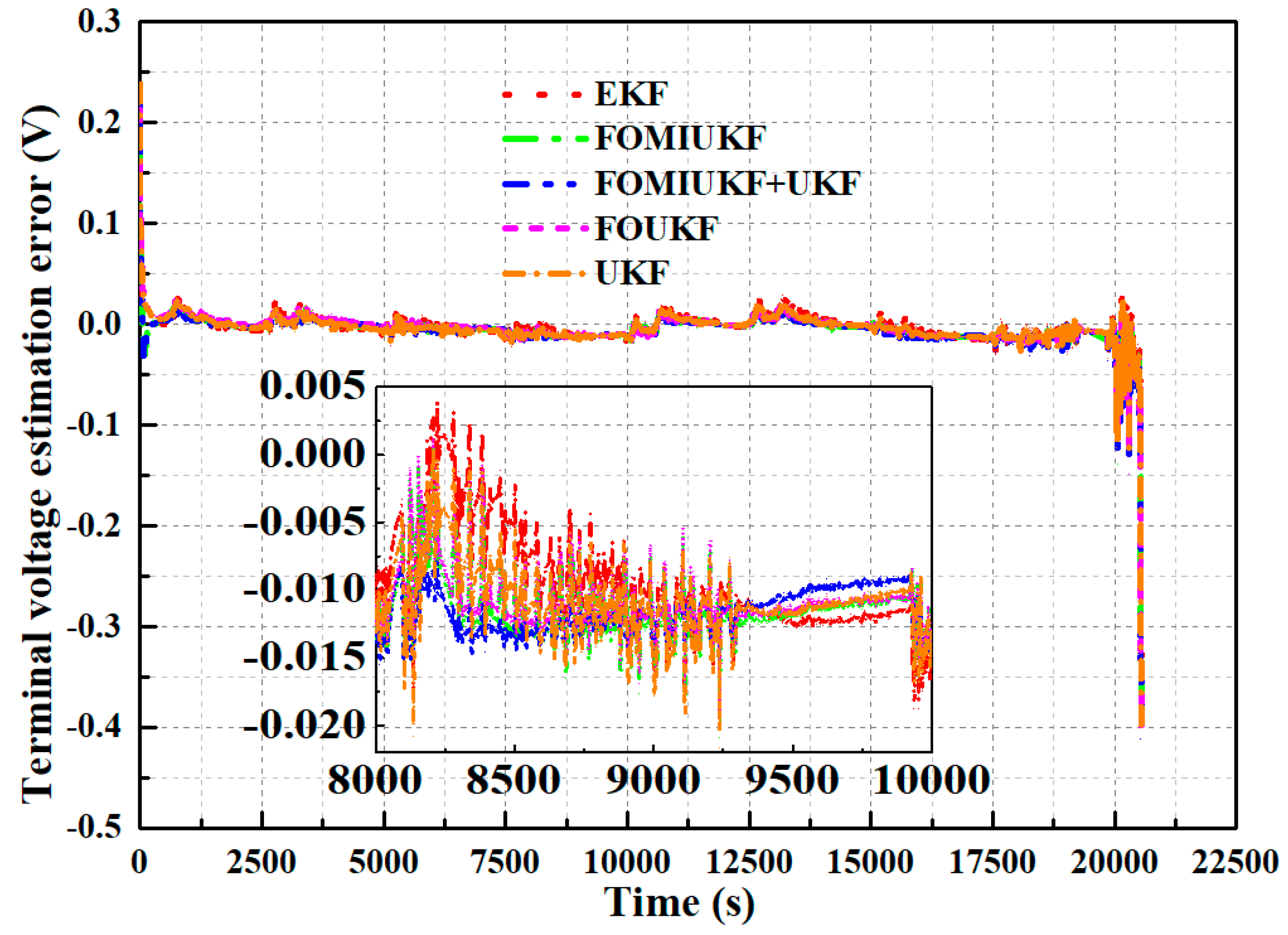
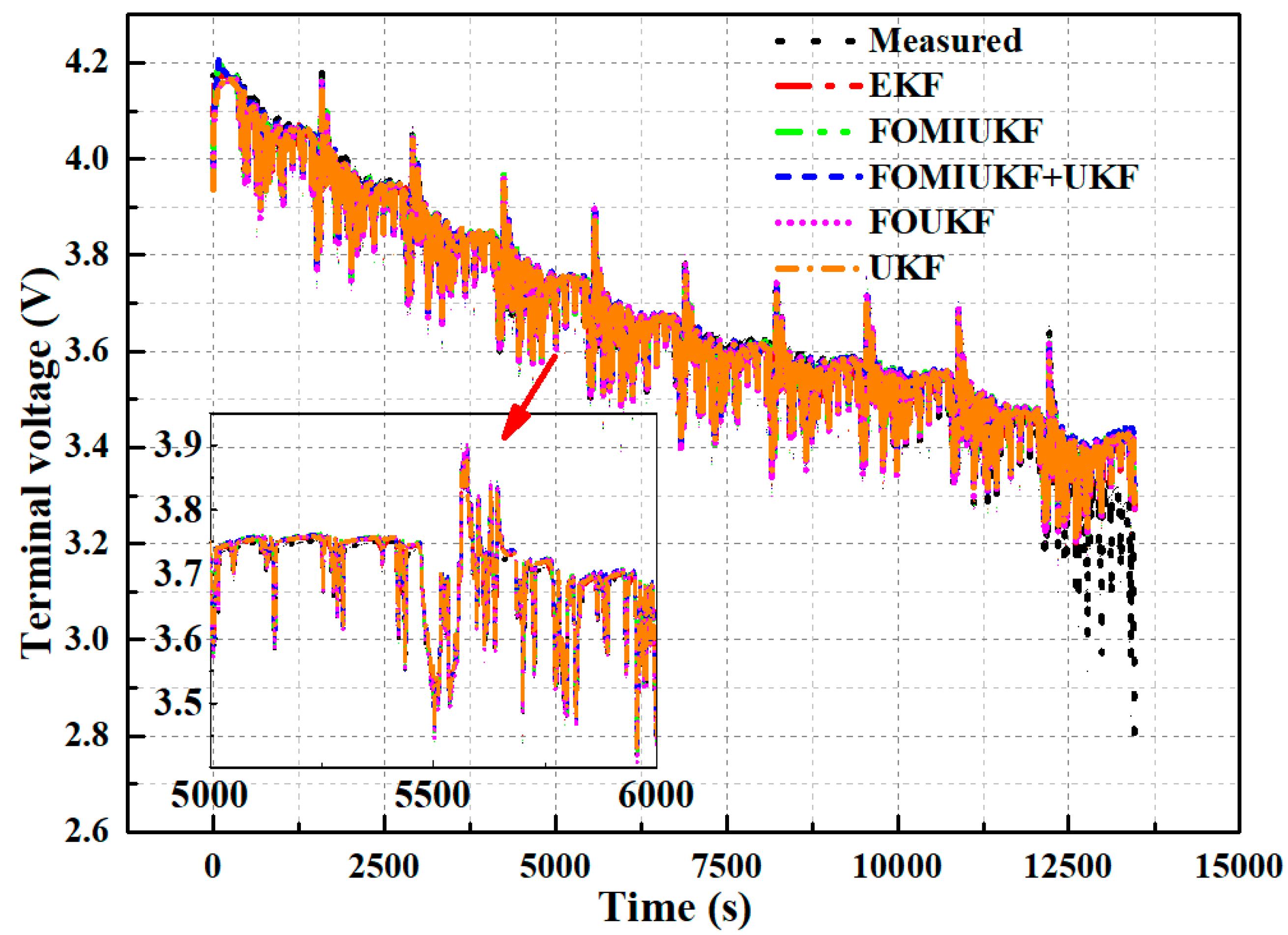
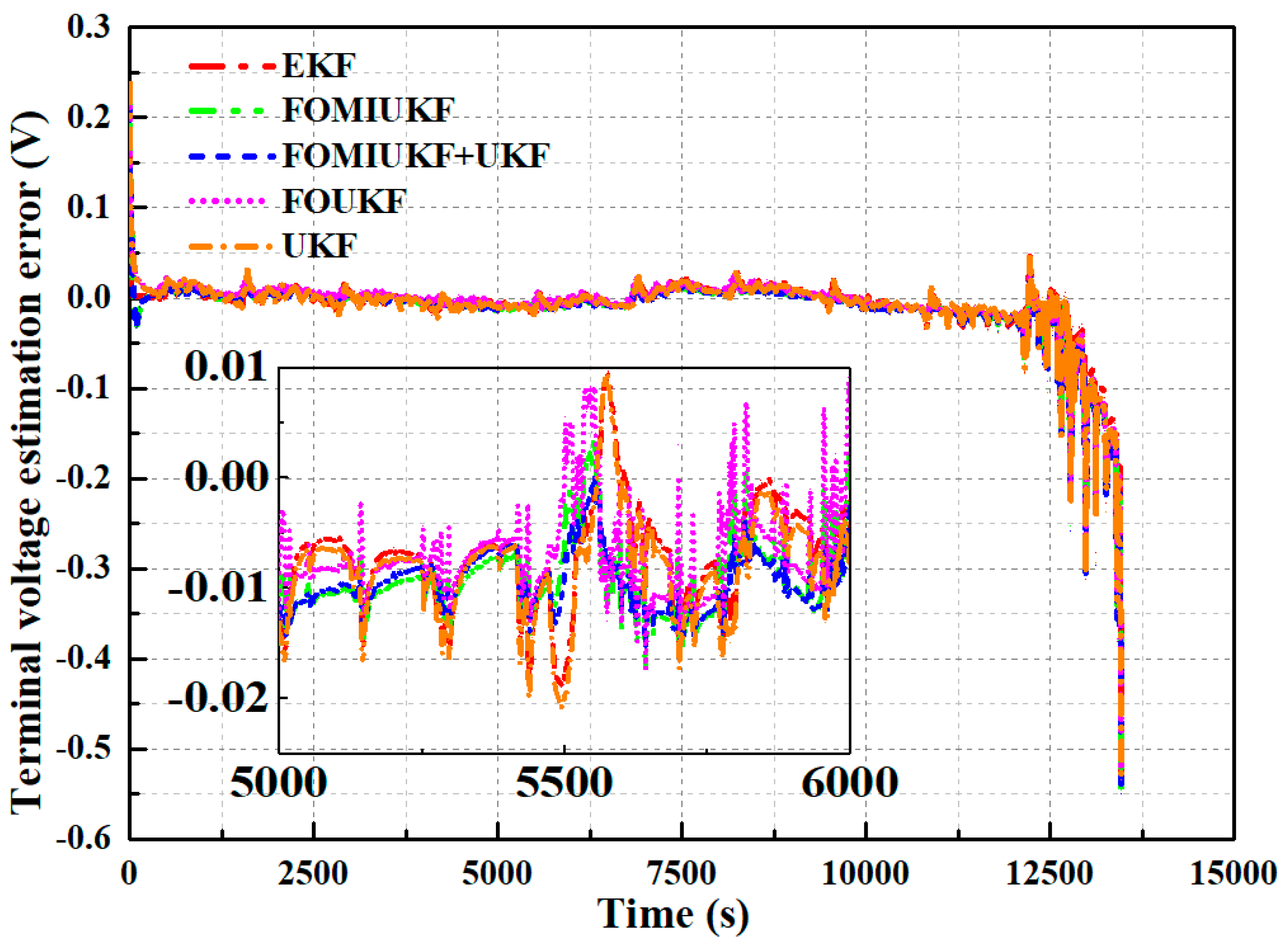

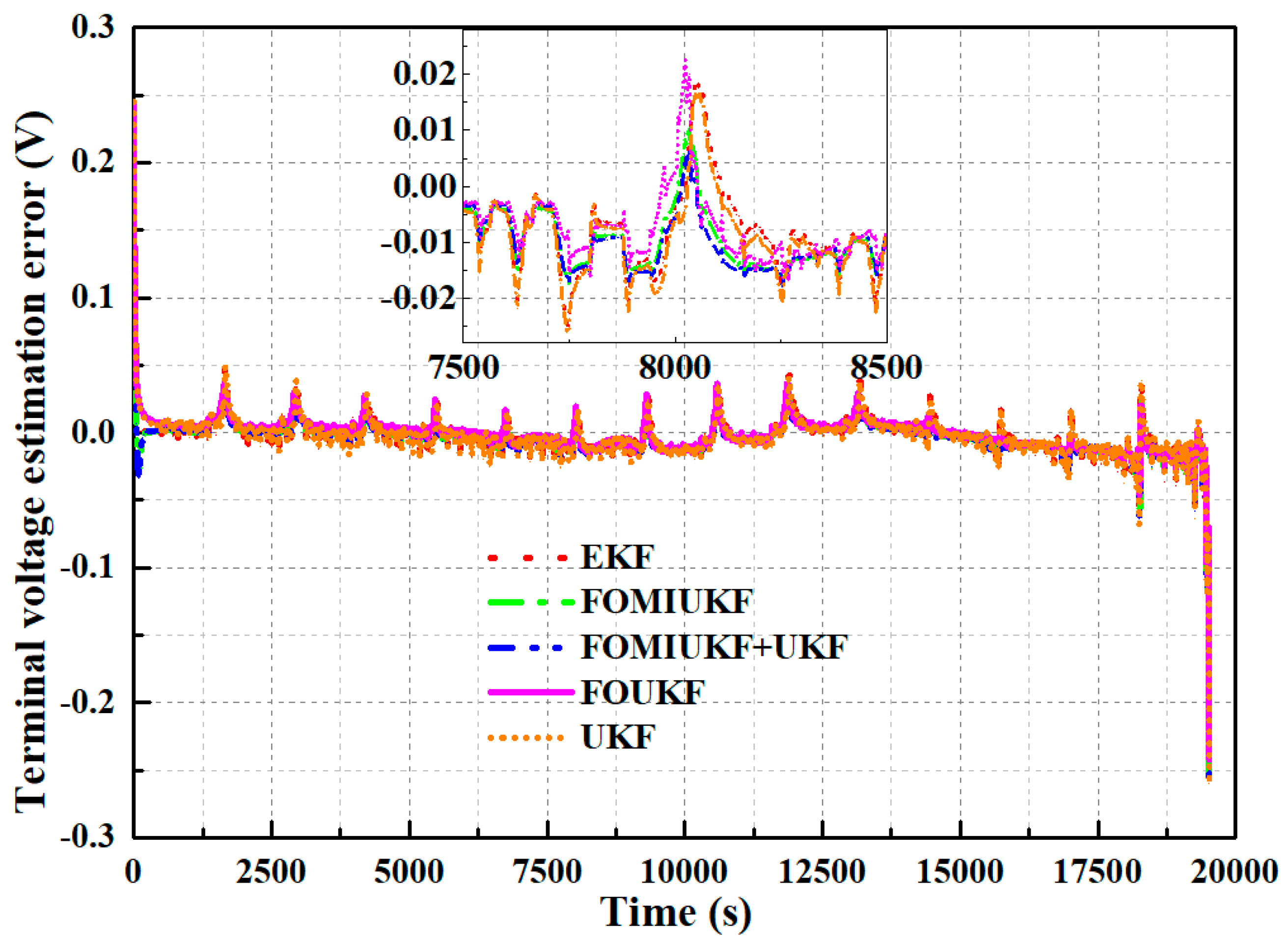
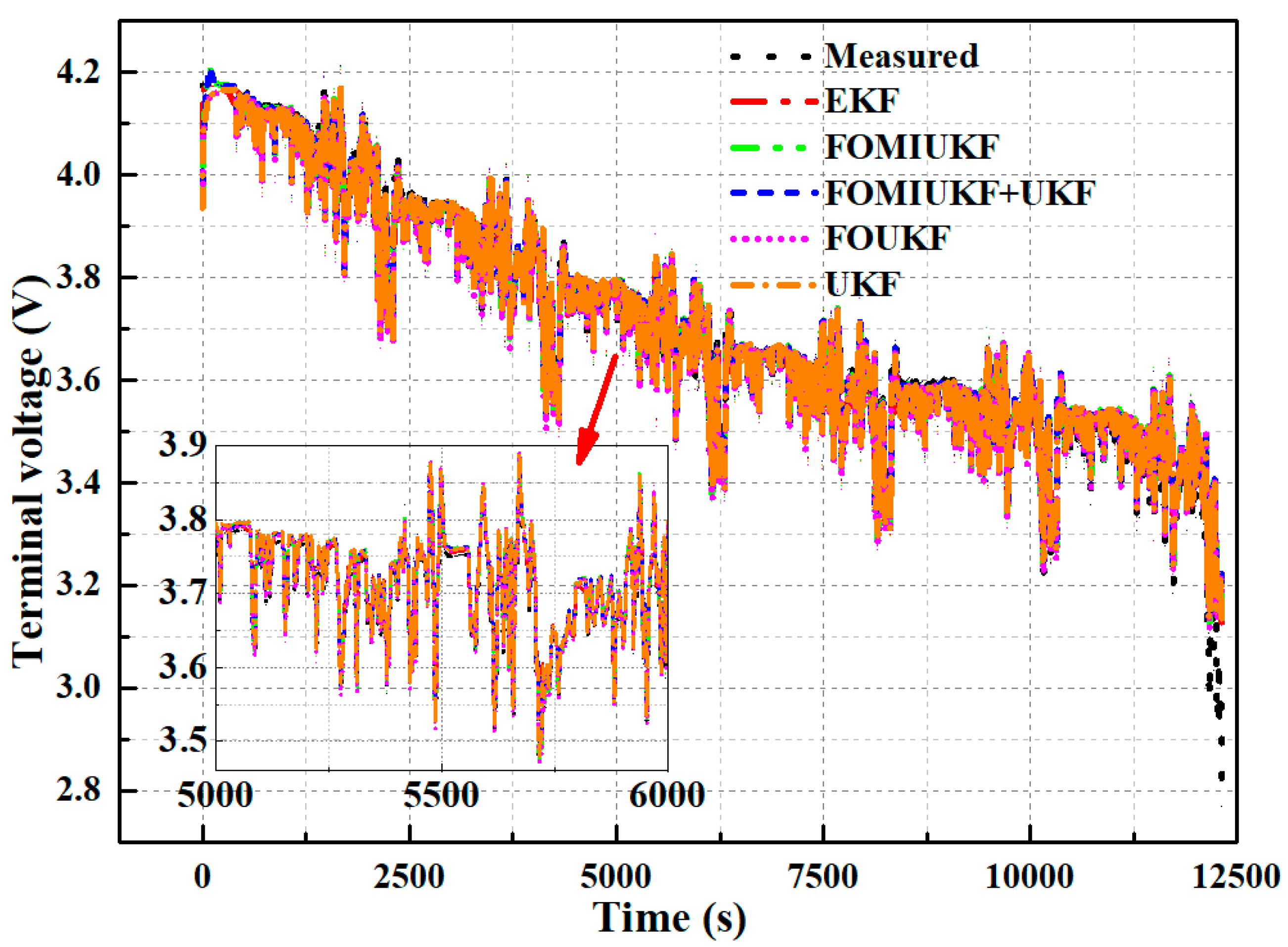
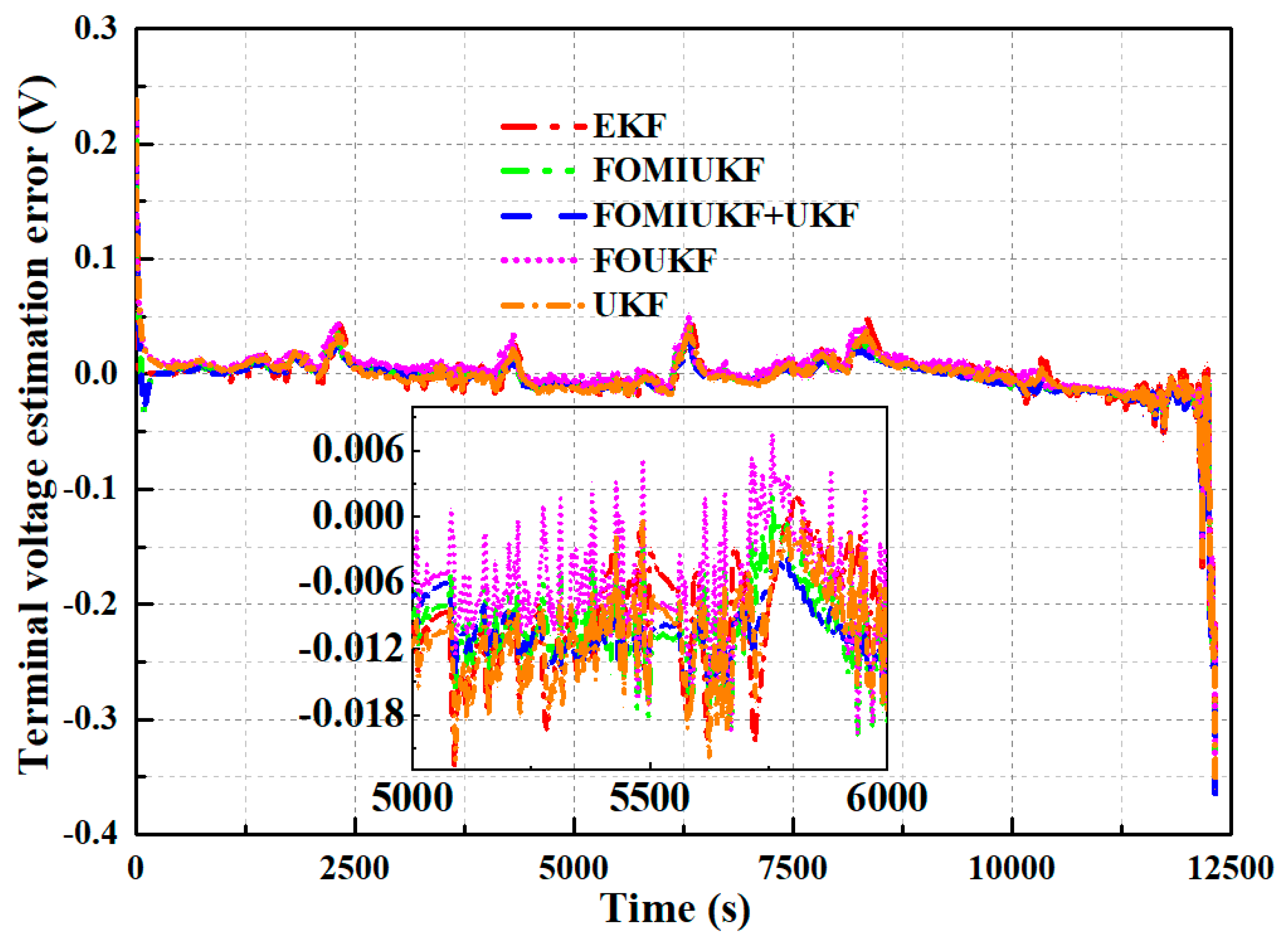
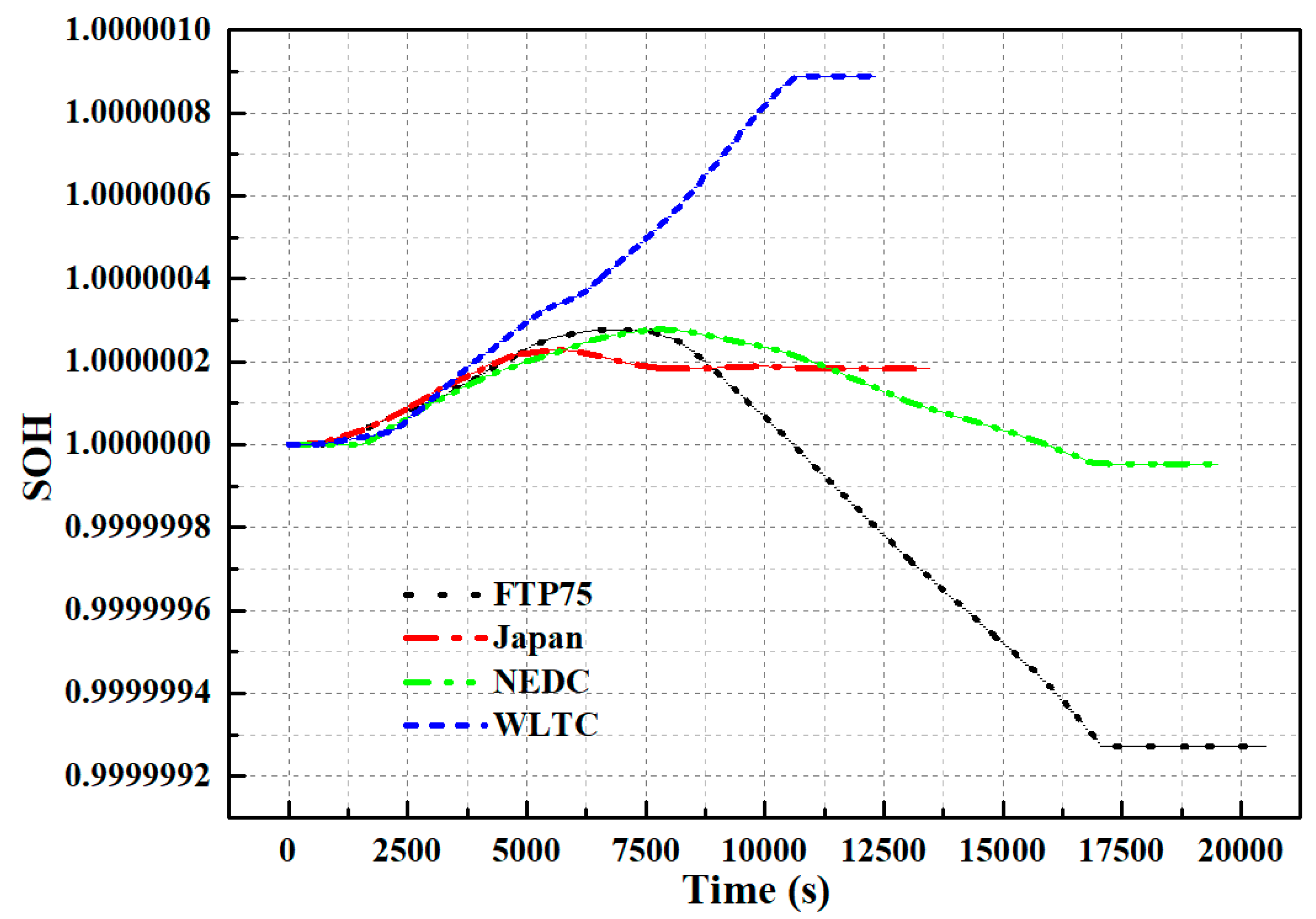
| Type | Nominal Capacity (0.5 C) | Upper Cut-Off Voltage | Lower Cut-Off Voltage | Charge Cut-Off Current |
|---|---|---|---|---|
| NCM523 | 2.6 A h | 4.2 V | 2.75 V | 0.05 C |
| R0/Ω | R1/Ω | R2/Ω | C1/F | C2/F |
|---|---|---|---|---|
| 0.0494 | 0.0286 | 0.0171 | 3029.5 | 85,581 |
| R0/Ω | R1/Ω | R2/Ω | C1/F | C2/F | m | n |
|---|---|---|---|---|---|---|
| 0.0494 | 0.0329 | 0.0255 | 1151.6 | 43,592 | 0.8063 | 0.989 |
| Mean Absolute Error (V) | Root Mean Square Error (V) | |
|---|---|---|
| Integer-order model | 0.0027 | 0.024 |
| Fractional-order model | 0.0026 | 0.0205 |
| FTP75 | Japan | NEDC | WLTC | |||||
|---|---|---|---|---|---|---|---|---|
| MAE | RMSE | MAE | RMSE | MAE | RMSE | MAE | RMSE | |
| EKF | 1.2 | 1.91 | 1.39 | 2.01 | 1.51 | 2.12 | 1.69 | 2.25 |
| UKF | 0.84 | 1.66 | 1.28 | 2.01 | 1.38 | 2.09 | 1.53 | 2.25 |
| FOUKF | 0.69 | 1.13 | 1.05 | 1.6 | 1.2 | 1.48 | 1.16 | 1.44 |
| FOMIUKF | 0.57 | 1.05 | 0.88 | 1.25 | 1.01 | 1.45 | 1.09 | 1.38 |
| FOMIUKF + UKF | 0.39 | 0.94 | 0.68 | 1.09 | 0.88 | 1.35 | 0.76 | 1.08 |
Publisher’s Note: MDPI stays neutral with regard to jurisdictional claims in published maps and institutional affiliations. |
© 2022 by the authors. Licensee MDPI, Basel, Switzerland. This article is an open access article distributed under the terms and conditions of the Creative Commons Attribution (CC BY) license (https://creativecommons.org/licenses/by/4.0/).
Share and Cite
Xu, Y.; Li, C.; Wang, X.; Zhang, H.; Yang, F.; Ma, L.; Wang, Y. Joint Estimation Method with Multi-Innovation Unscented Kalman Filter Based on Fractional-Order Model for State of Charge and State of Health Estimation. Sustainability 2022, 14, 15538. https://doi.org/10.3390/su142315538
Xu Y, Li C, Wang X, Zhang H, Yang F, Ma L, Wang Y. Joint Estimation Method with Multi-Innovation Unscented Kalman Filter Based on Fractional-Order Model for State of Charge and State of Health Estimation. Sustainability. 2022; 14(23):15538. https://doi.org/10.3390/su142315538
Chicago/Turabian StyleXu, Yonghong, Cheng Li, Xu Wang, Hongguang Zhang, Fubin Yang, Lili Ma, and Yan Wang. 2022. "Joint Estimation Method with Multi-Innovation Unscented Kalman Filter Based on Fractional-Order Model for State of Charge and State of Health Estimation" Sustainability 14, no. 23: 15538. https://doi.org/10.3390/su142315538
APA StyleXu, Y., Li, C., Wang, X., Zhang, H., Yang, F., Ma, L., & Wang, Y. (2022). Joint Estimation Method with Multi-Innovation Unscented Kalman Filter Based on Fractional-Order Model for State of Charge and State of Health Estimation. Sustainability, 14(23), 15538. https://doi.org/10.3390/su142315538








